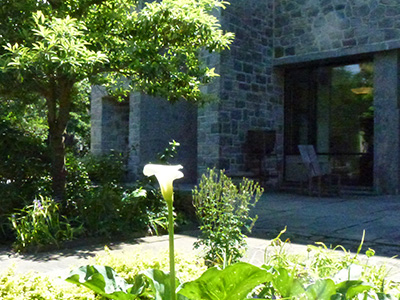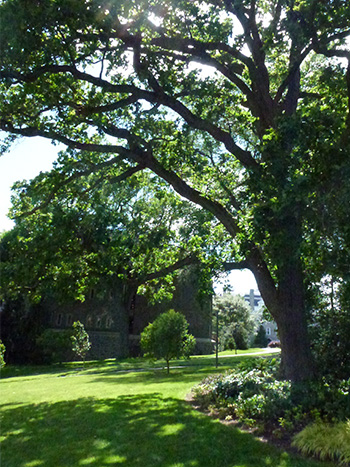Plant of the Week: June 13
Zantedeschia ‘White Giant’
Zantedeschia ‘White Giant’ is a gorgeous calla lily, consisting of a single, spiraled spadix brightly complementing its dark green foliage. Native to southern Africa, the calla lily migrated throughout the world’s gardens as early as 1664, and has since become a staple of wedding and funeral arrangements. Found here in the Isabelle Cosby Courtyard Garden, the single cream-colored flower seems to scream for attention through its green surroundings. It is poetic in its solitude. But a word of warning to those with pets: should you choose to plant this at home, its tissues contain oxalic acid, a poison which will cause irritation in humans, but could be deadly to pets. Photo Credit: D. Morreale
Quercus macrocarpa
While some will prefer the bright, showy colors of the flowers that fill the Arboretum, I am personally drawn to the majesty and timelessness of trees. This Quercus macrocarpa, located just behind the Terry Shane Teaching garden, is a prime example. This oak, planted as the class tree in 1876 provides a stunning canopy. The state tree of Iowa, this example of oak prefers to grow in solitude, and is native to the Great Plain. Technicalities aside, I truly love all of the oaks that surround campus, but this one holds a special place to me as a native of Swarthmore, as I recall playing in the grass under this bur oak, and sitting with my parents around the fish pond of the garden, also shaded by this tree. Photo Credit: D. Morreale
Schizophragma hydrangeoides ‘Moonlight’
Schizophragma hydrangeoides ‘Moonlight’ graces the stone breezeway between Clothier Hall and the Bell tower, welcoming passersby with a light, sweet scent. The large white inflorescence of this slow growing Japanese hydrangea strongly contrast against the green and gray backdrops and give the side of Clothier a timeless, classic feel, as though you were approaching a 19th century castle. Luckily, its beauty is not limited to the summer: In fall the leaves change to a bright yellow, and in winter, the tangle of woven tendrils create an amazing pattern on the arches, especially when covered in a light dusting of snow. And the best part: this vine is very tolerant of a shaded environment, which means no trees need to be removed should you want to grow it in a less than ideal Swarthmore garden. Photo Credit: D. Morreale








Lucy Wood
Posted at 18:51h, 19 JuneSo glad to see the bur oak featured, but is it not Macrocarpa, rather than marcocarpa? We have a small one I treasure. It is growing quite happily here.
I’d love for you to include the lovely planting you have of cercis canadensis ‘Forest Pansy’ (?) paired with aristolochia—beautiful purple and green contrast with virtually the same leaves, but very different habit.
Thanks,
Lucy Wood
Becky Robert
Posted at 12:19h, 21 JuneHi Lucy,
Good eye! It is indeed Quercus macrocarpa. I agree – the purple leaf Cercis are beautiful. There are several newer purple foliage cultivars on the market: ‘Ruby Falls’ and ‘Merlot’ to name two.